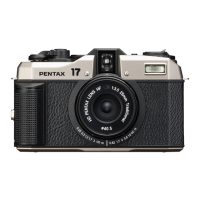36
4
Appendix
Handling Precautions
Before Using Your Camera
• When the camera has not been used for a long time, confirm that it is still working
properly, particularly prior to taking important photos (such as at a wedding or when
traveling). Contents of taken photos cannot be guaranteed if photo development,
etc. is not possible due to a malfunction of your camera.
Precautions on Carrying and Using Your Camera
• Do not subject the camera to high temperatures or high humidity. Do not leave the
camera in a vehicle, as the temperature can get very high.
• Do not subject the camera to strong vibrations, shocks, or pressure. Use a cushion to
protect the camera from vibrations of motorcycles, automobiles, or ships.
• Sudden temperature changes will cause condensation on the inside and outside of
the camera. Place the camera in your bag or a plastic bag, and remove it after tem-
peratures of the camera and surroundings are equalized.
• Avoid contact with garbage, mud, sand, dust, water, toxic gases, or salt. These could
cause the camera to breakdown. Wipe the camera to dry off any rain or water drops.
• The camera is not water resistant, so it cannot be used in places where it will get wet,
such as in the rain.
• Do not leave the camera for long periods of time in direct sunlight with film left inside.
Doing so may expose the film.
• Be careful not to overtighten the screw in the tripod socket when using a tripod.
Cleaning Your Camera
• Do not clean the camera with organic solvents such as thinner, alcohol, and benzine.
• Use a lens brush to remove dust accumulated on a lens. Never use a spray blower for
cleaning as it may damage the lens.
• Periodic inspections are recommended every one to two years to maintain high per-
formance.

